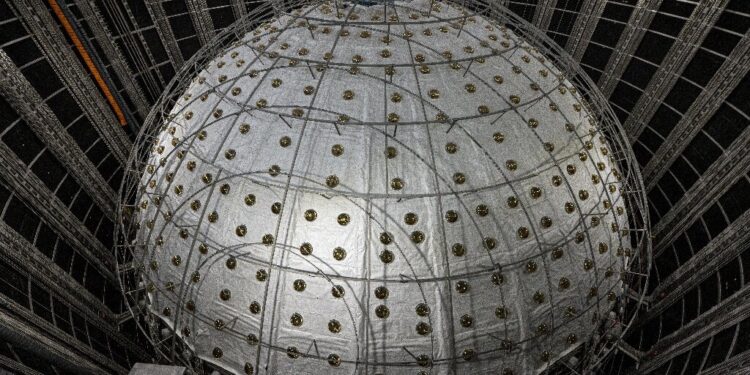Inside is the neutrino detector, a stainless steel and acrylic sphere about 35 meters in diameter, crisscrossed with cables.
Far beneath the lush landscape of southern China, a vast underground laboratory aims to be the first in the world to solve a profound scientific enigma.
China has emerged as a scientific powerhouse in recent years, with the country’s communist leaders investing billions of dollars in advanced research to compete with the United States and other rivals.
Its latest centerpiece is the Jiangmen Underground Neutrino Observatory (Juno), a cutting-edge facility for the study of tiny subatomic particles.
The project is an “exciting” opportunity to delve into some of the most fundamental, yet elusive, building blocks of the universe, according to Patrick Huber, director of the Center for Neutrino Physics at Virginia Tech, who is not involved in the project. research.
AFP recently took part in an international media tour of the Kaiping Observatory in Guangdong province, organized by the Chinese Academy of Sciences, the country’s national science agency.
The laboratory is accessible by a funicular that descends through a tunnel to a cavern built 700 meters (2,300 feet) underground to limit radiation emissions.
Inside is the neutrino detector, a stainless steel and acrylic sphere about 35 meters in diameter, crisscrossed with cables.
“No one has built such a detector before,” said Wang Yifang, Juno project manager and director of the Institute of High Energy Physics, as workers wearing hard hats applied the finishing touches to the detector. glowing orb.
“You can see from the scale, it was technologically complicated,” Wang said, waving a laser pen over different parts of the installation.
Launched in 2014, Juno cost around 2.2 billion yuan ($311 million) to build and is expected to be completed next year.
His goal is to solve a fundamental physics puzzle about the nature of particles faster than scientists in the United States, the world leader in the field.
His research could also help us better understand planet Earth, the Sun and other stars and supernovas.
China has become a scientific powerhouse in recent years, with the country’s communist leaders investing billions of dollars in advanced research.
“The second one doesn’t mean anything.”
Neutrinos are elementary particles that exist all around us and travel at close to the speed of light.
Physicists have known about them for decades but still lack in-depth knowledge of how they work.
Researchers will use Juno to detect neutrinos emitted by two Chinese nuclear power plants, each located 53 kilometers (33 miles) away.
They will then use the data to solve the so-called “mass hierarchy” problem, considered crucial for improving theories of particle physics.
Scientists already know that neutrinos come in three different mass states, but they don’t know which is heaviest and which is lightest.
Solving this problem could help them better understand the Standard Model of particle physics, allowing them to learn more about the past and future of the universe.
“(The project) will thoroughly test our understanding of neutrino oscillation and quantum mechanics,” said Huber of Virginia Tech.
“If it turns out that Juno shows that our (current) understanding is wrong, then that would be a revolution.”
Wang, the project leader, said the researchers were confident they would “get the mass hierarchy result before anyone else.”
In basic sciences, he said with a smile, “the first means everything, and the second means nothing”.
The laboratory is accessible by a funicular that descends through a tunnel to a cavern built 700 meters (2,300 feet) underground to limit radiation emissions.
Tensions between superpowers
Scientists estimate that six years of data will be needed to resolve the mass hierarchy question.
And although similar experiments will take place in the United States and Japan in the coming years, Juno is “ahead of the race,” said Jennifer Thomas, a physicist at University College London and a member of the international scientific committee. of the project.
About 750 scientists from 17 countries are participating in this collaboration, including “two American groups,” according to Wang.
Others are interested in joining, he added, “but unfortunately, for many well-known reasons…they are not allowed to.”
As competition between the United States and China in science and technology intensifies, Washington has investigated American academics of Chinese origin for espionage or theft of intellectual property, and encouraged institutions nationals to loosen their ties with their Chinese counterparts.
Beijing, for its part, has been accused by Western governments and international organizations of restricting access to certain data and hindering investigations into sensitive subjects, such as the origins of COVID-19.
But an American academic and Juno member said he was looking forward to working on the “unique” project.
“We are not completely insensitive to the political situation, because sometimes there can be difficulties (for researchers) in obtaining visas” and overcoming stricter bureaucratic hurdles, said Juan Pedro Ochoa-Ricoux, an experimental physicist at the University of California at Irvine. AFP.
He said such issues “affect both sides, perhaps even more our Chinese colleagues than us in the United States.”
But, he added, “by working together, we also show how science can and should be apolitical.”
© 2024 AFP
Quote: A Chinese underground laboratory seeks an answer to a profound scientific enigma (October 17, 2024) retrieved October 17, 2024 from
This document is subject to copyright. Except for fair use for private study or research purposes, no part may be reproduced without written permission. The content is provided for informational purposes only.



